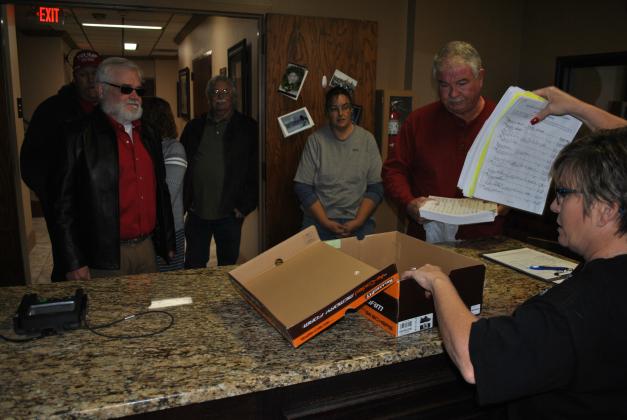Organizers delivered what they said were the signatures of more than 1,100 registered voters attached to petitions calling for Scurry County to hold a rollback election of its 2020 tax rate.
Morgan Preston, Gayle Summers, Mel Heard, Mitch Hickman, Clay Mize and Ali Mize delivered a stack of 270 petitions containing 1,139 signatures to Scurry County Clerk Melody Appleton’s office Friday morning. Preston said they may deliver additional petitions Monday, the deadline for doing so.
Earlier this year the county adopted a tax rate of 44.98 cents per $100 valuation, which is the same rate as 2019. However, due to increased valuations, the county is scheduled to collect millions in additional ad valorem, or property tax, revenue.
Among the larger expenses the additional money had been designated for are emergency reserves ($1 million), employee raises ($230,000 on top of a 2.8 percent cost of living increase), new software in the criminal justice offices ($278,000) and new voting machines ($167,000).
But those plans may now be in question. If at least 644 of the signatures are found to be from registered voters, the county’s tax rate will be open to a public vote.
Voters will decide whether the county will collect the existing rate, or be forced to adopt the rollback rate of 34.97 cents per $100 valuation.
The petitions were due Monday, according to state law, but organizers turned them in Friday with the request that the rollback election be scheduled on the same day as the Republican and Democratic primaries.
However, the Texas Election Code will not allow that.
“Texas Election Code does not allow other elections on the date of a primary election,” she said. “The county commissioners will have to choose a date to hold it. The commissioners’ court will discuss and choose a date.”
The reason for the primary day recommendation was to save the taxpayers’ the $4,000 to $5,000 it will cost to hold an election.
“We can’t do it,” Appleton said.
Now that the signatures have been submitted, what’s next?
The next step is to determine if the petition is valid
According to information from the Texas Comptroller’s office, the taxing unit's governing body is responsible for determining if a rollback petition presented to it is valid.
Once the governing body determines that a petition is valid, it must adopt a resolution regarding its validity within 20 days of receiving it. If the governing body takes no action within that time, the petition is automatically valid.
Appleton said it was her understanding that the 20 days were calendar days and not business days, but added she was checking with the state for clarification.
To validate the signatures, Appleton’s staff will enter each name into a program and check whether it belongs to a registered voter.
“It’s a program called TEAM (Texas Election Administration Management) with the Secretary of State,” she said. “We’ll manually enter each name and it will have to be active or in suspense to be declared valid.”
If the governing body finds the petition invalid, it may be a good practice for the resolution or order setting it aside to specify the reasons why it is invalid. The taxing unit should consult its attorney, according to the comptroller.
Calling for an election
If the governing body for a taxing unit determines the rollback petition is valid, the governing body must set a rollback election date. This date cannot be earlier than 30 days or later than 90 days after the last date the governing body could have ruled on the validity of the petition.
The requirement that local elections be held on a specified date does not apply to this election, unless a specified date falls within the permitted 30 to 90 days. More information about election dates may be obtained from the Election Division of the Secretary of State's Office.
The election ballots must contain statutory language that permits voting for or against the proposition. While the Comptroller's office provides a Sample Tax Rate Rollback Ballot, it suggests governing bodies consult legal counsel for guidance.
What happens after the election?
If the rollback fails, the taxing unit's adopted tax rate stands. A simple majority is necessary for passing the rollback election.
If the rollback election passes, a taxing unit must reduce its tax rate for the current year to the rollback tax rate. The taxing unit's tax assessor must prepare and mail new tax bills.
The taxing unit's delinquency date is postponed by the number of days between the date original bills were mailed and the date the corrected bills were mailed.
If the taxing unit has begun collecting taxes at the time of the election, some taxpayers may have paid taxes under the original tax rate. The taxing unit must refund the difference between the taxes paid under the original tax rate and taxes levied under the rollback tax rate. The taxing unit has 60 days from the date the election results are counted to send refunds.
A taxing unit sends refunds resulting from a rollback election if the refund amount is $1 or more. If the amount is less than $1, the taxing unit shall refund the difference upon the taxpayer's request.
The taxpayer must apply for the refund of less than $1 within 90 days after the date the refund becomes due or forfeit the right to the refund.
After 60 days, taxing units must pay interest on refunds. The interest is 1 percent per month, or part of a month, from the date that the election results were certified to the date the refund is mailed.


